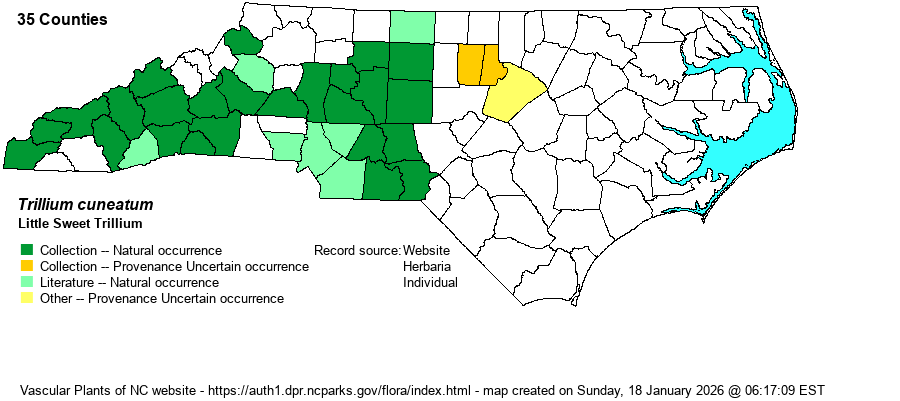| Author | Rafinesque | |
| Distribution | Essentially restricted to the central and western Piedmont and southern half of the Mountains, with disjunct (native?) records east to Wake County and north to Rockingham and Watauga counties. Basically, it ranges from Guilford, Randolph, Montgomery, and Richmond counties westward.
This is a South-central trillium species, with its main range west of the Atlantic Coastal Plain. As with T. catesbaei, it also does not quite range north to VA, but it does range into KY, then south to central portions of GA, AL, and MS. There are disjunct records in the Coastal Plain of SC where limey soils locally prevail.
| |
| Abundance | Uncommon to infrequent, local in occurrence, but can be numerous where conditions are favorable (i.e., higher pH soils). It is most frequent in the far southwestern Piedmont -- South Mountains and Polk County -- and the adjacent southern Mountains. Into the central Piedmont, it is rare to locally uncommon, though it can be more frequent in the Uwharrie Mountains (Randolph, Stanly, and Montgomery counties). It is less common and widespread than T. catesbaei where both occur in the same county. | |
| Habitat | This is one of many trillium species essentially restricted to moist circumneutral, forested soils. It is thus found primarily in Basic Mesic Forest and Rich Cove Forest natural communities. It also occurs in rich bottomland hardwood forests, as well. It can be found with a few other trillium species in the Mountains, but in the Piedmont it is found mostly just with the scarce T. rugellii; the widespread T. catesbaei may be found with it, but it normally grows on less rich soils. |
| Phenology | Blooms in rather early spring, from mid-March into mid- or late April (depending on elevation). Fruits from late May into June. | |
| Identification | This is one of the trillium species with mottled leaves, they being blotched with patches of light green and purple. The stems grow to about 6 inches tall, and the three leaves are widely elliptic to more often deltoid in shape -- roughly 4-5 inches long and nearly as wide. The single flower is sessile and erect, above the leaves. The three petals are usually brown/purple/maroon, but can occasionally be yellow to yellow-green. They are narrowly lanceolate to elliptic and about 2 inches long, slightly spreading; the leaves tend to be angled somewhat diagonally downward. The plants with purplish brown petals are distinctive in the central and western parts of NC, but the yellow-green form is quite similar to T. luteum, common in the Great Smoky Mountains National Park and nearby places. T. cuneatum, however, has portion of the stamens and ovary purple or purplish in color during flowering, wheras T. luteum flowers have stamens and ovary greenish white, somewhat matching the flower color. Note that along the Roanoke River in Halifax and Northampton counties, well east of the range of T. cuneatum, T. sessile is rather similar. Check keys for differences, in case you find an erect, purple-flowered trillium in the northeastern Piedmont away from the Roanoke floodplain. Trlliums are typically conspicuous where they occur, so such a finding is highly unlikely. | |
| Taxonomic Comments | This has always been a good species, but decades ago T. luteum was included within it, as T. cuneatum var. luteum, and thus the plants with dark ovaries and stamens were the nominate T. cuneatum var. cuneatum. Thankfully, nearly all recent references split these out, and thus T. cuneatum is no longer split up. Some other species outside of NC were at one time included within this species and have alos been pulled out as new species.
| |
| Other Common Name(s) | Little Sweet Betsy, Sweet Betsy, Purple Toadshade, Large Toadshade, Wedge-petal Trillium, and quite a few other names. Though Little Sweet Betsy is indeed a more often used name than is xxxxxx Trillium, NatureServe names it as Little Sweet Trillium, and it is best not to use colloquial, idiosyncratic names like "Sweet Betsy" as a group name for a handful of species, particularly in a genus where most other species are named as xxxxxx Trillium. | |
| State Rank | S3 [S4] | |
| Global Rank | G4G5 | |
| State Status | | |
| US Status | | |
| USACE-agcp | | |
| USACE-emp | | |

